

![]()
W. H. Hudson
1841-1922
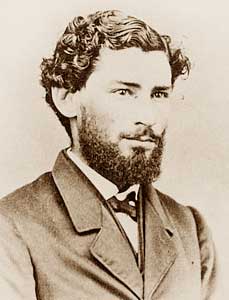
W. H. Hudson as a young man.
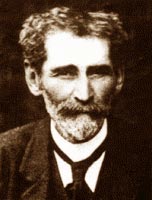 William Henry Hudson was born near Buenos Aires,, the son of New Englanders who took up sheep farming in Argentina. He grew up on his father's estate on the pampas, and the life there shaped his later life as an author, naturalist, and ornathologist. Like so many authors of his day, illness in childhood (and the vast distances on the pampas) kept him from going to school away from home and he spent many hours wandering alone on the pampas, where he saw gauchos and shepherds, vast flocks of sheep and birds; and reading books. His only formal education was from a visiting school teacher, and he grew up somewhat shy but adventurous and observant. When grown, he travelled Argentina, Brazil, Uruguay, and Patagonia on horeback, collecting specimens and keeping diaries.
William Henry Hudson was born near Buenos Aires,, the son of New Englanders who took up sheep farming in Argentina. He grew up on his father's estate on the pampas, and the life there shaped his later life as an author, naturalist, and ornathologist. Like so many authors of his day, illness in childhood (and the vast distances on the pampas) kept him from going to school away from home and he spent many hours wandering alone on the pampas, where he saw gauchos and shepherds, vast flocks of sheep and birds; and reading books. His only formal education was from a visiting school teacher, and he grew up somewhat shy but adventurous and observant. When grown, he travelled Argentina, Brazil, Uruguay, and Patagonia on horeback, collecting specimens and keeping diaries.
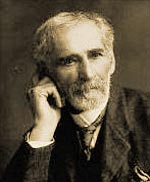 In 1869, after the death of his parents, he moved to London. There he spent years in poverty, far from the countryside that he loved, and he began to write. His most popular books were Green Mansions, a South American romance; The Purple Land That England Lost, about Banda Oriental (Colonial Uruguay); and books about British and South American birds. He married and became a British citizen in 1900. He also wrote articles and essays for London magazines and journals of the day. He was a founding member of the Royal Society for the Protection of Birds.
In 1869, after the death of his parents, he moved to London. There he spent years in poverty, far from the countryside that he loved, and he began to write. His most popular books were Green Mansions, a South American romance; The Purple Land That England Lost, about Banda Oriental (Colonial Uruguay); and books about British and South American birds. He married and became a British citizen in 1900. He also wrote articles and essays for London magazines and journals of the day. He was a founding member of the Royal Society for the Protection of Birds.
The book that most interests us, though, is A Shepherd's Life: Impressions of the South Wiltshire Down, published in 1910, which some think may be his best work. For the first few chapter, Hudson describes the Salisbury Plain and the South Wiltshire Downs, its flora and fauna, and how it had changed in the previous 50 years.
In Chapter IV, Hudson introduces us to Caleb Bawcombe, a shepherd of the South Wiltshire Downs, and the rest of the book is about Caleb, his reminisances, his family, and their life on the Downs. A good part of the book is taken up with descriptions of and stories about sheepdogs, how they work, their individual personalities and quirks, and Caleb's and the other shepherds' relationship with their dogs. It isn't always pretty, as life as a shepherd was hard, both for the shepherds and their dogs; but it is always facinating. Here are some excerpts from the book, thanks to the Project Gutenberg Literary Archive:
I was talking to a shepherd, a fine intelligent fellow, keenly interested in the subjects of sheep and sheep-dogs, on the high down above the village of Broad Chalk on the Ebble, and he told me that his dog was of mixed breed, but on its mother's side came from a Welsh sheep-dog, that his father had always had the Welsh dog, once common in Wiltshire, and he wondered why it had gone out as it was so good an animal.
. . .
...Caleb got married, and resolved to leave the old farm at Bishop to take a better place at a distance from home, at Warminster, which had been offered him. He would there have a cottage to live in, nine shillings a week, and a sack of barley for his dog. At that time the shepherd had to keep his own dog--no small expense to him when his wages were no more than six to eight shillings a week.
. . .
His best memories of this period relate to his mother and to two sheepdogs, Jack at first and afterwards Rough, both animals of original character. Jack was a great favourite of his master, who considered him a "tarrable good dog." He was rather short-haired, like the old Welsh sheepdog once common in Wiltshire, but entirely black instead of the usual colour--blue with a sprinkling of black spots...Rough was a large, shaggy, grey-blue bobtail bitch with a white collar. She was a clever, good all-round dog, but had originally been trained for the road, and one of the shepherd's stories about her relates of her intelligence in her own special line--the driving of sheep.
One day he and his smaller brother were in charge of the flock on the down, and were on the side where it dips down to the turnpike-road about a mile and a half from the village, where a large flock, driven by two men and two dogs, came by. They were going to the Britford sheep-fair and were behind time; Isaac had started at daylight that morning with sheep for the same fair, and that was the reason of the boys being with the flock. As the flock on the down was feeding quietly the boys determined to go to the road to watch the sheep and men pass, and arriving at the roadside they saw that the dogs were too tired to work and the men were getting on with great difficulty. One of them, looking intently at Rough, asked if she would work. "Oh, yes, she'll work," said the boy proudly, and calling Rough he pointed to the flock moving very slowly along the road and over the turf on either side of it. Rough knew what was wanted; she had been looking on and had taken the situation in with her professional eye; away she dashed, and running up and down, first on one side then on the other, quickly put the whole flock, numbering 800, into the road and gave them a good start.
"Why, she be a road dog!" exclaimed the drover delightedly.
. . .
On receiving [a] pup he was told that its name was Tory, and he did not change it. It was always difficult, he explained, to find a name for a dog--a name, that is to say, which anyone would say was a proper name for a dog and not a foolish name. One could think of a good many proper names--Jack and Watch, and so on--but in each case one would remember some dog which had been called by that name, and it seemed to belong to that particular well-remembered dog and to no other, and so in the end because of this difficulty he allowed the name to remain.
. . .
[I was] reminded...of an equally good story of the recovery of a lost dog which I heard from a shepherd on the Avon. He had been lost over a year, when one day the shepherd, being out on the down with his flock, stood watching two drovers travelling with a flock on the turnpike road below, nearly a mile away, and by and by hearing one of their dogs bark he knew at that distance that it was his dog. 'I haven't a doubt,' he said to himself, 'and if I know his bark he'll know my whistle.' With that he thrust two fingers in his mouth and blew his shrillest and longest whistle, then waited the result. Presently he spied a dog, still at a great distance, coming swiftly towards him; it was his own dog, mad with joy at finding his old master.
Did ever two friends, long sundered by unhappy chance, recognize each other's voices at such a distance and so come together once more! Whether the drovers had seen him desert them or not, they did not follow to recover him, nor did the shepherd go to them to find out how they had got possession of him; it was enough that he had got his dog back.
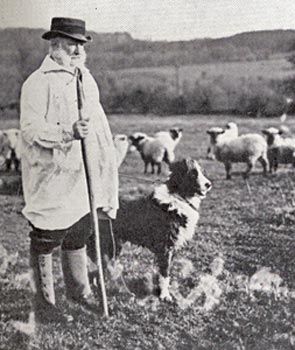
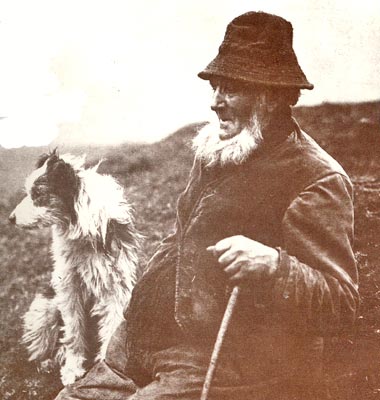 There are also two modern illustrated editions of A Shepherd's Life. The photo at right is of "a shepherd and his dog photographed in 1895" from The Illustrated Shepherd's Life (1987 The Bodley Head, London and Savitri Books Ltd.). The publisher is not exaggerating when he says "This illustrated edition is a celebration of the landscape Hudson so vividly describes. In a series of specially commissioned watercolours, Benjamin Perkins and others show the Wiltshire of today, while contemporary original works by W. Herbert Allen and the many archival photographs record the countryside, its people and their rural activities as they used to be." The photo on the left is of "a shepherd grazing his sheep on Hindon Down in about 1900" from A Shepherd's Life (1981 Book Club Associates by arrangement with Macdonald Futura Publishers Ltd.), which uses modern and archival photographs and other illustrations. Both books would be equally satisfying editions to anyone's collection.
There are also two modern illustrated editions of A Shepherd's Life. The photo at right is of "a shepherd and his dog photographed in 1895" from The Illustrated Shepherd's Life (1987 The Bodley Head, London and Savitri Books Ltd.). The publisher is not exaggerating when he says "This illustrated edition is a celebration of the landscape Hudson so vividly describes. In a series of specially commissioned watercolours, Benjamin Perkins and others show the Wiltshire of today, while contemporary original works by W. Herbert Allen and the many archival photographs record the countryside, its people and their rural activities as they used to be." The photo on the left is of "a shepherd grazing his sheep on Hindon Down in about 1900" from A Shepherd's Life (1981 Book Club Associates by arrangement with Macdonald Futura Publishers Ltd.), which uses modern and archival photographs and other illustrations. Both books would be equally satisfying editions to anyone's collection.
Copyright 2008 by Carole L. Presberg
THE OTHER WEB PAGES WE MAINTAIN
These web pages are copyright ©2013
and maintained by webmeistress Carole Presberg
with technical help from webwizard David Presberg
ALL RIGHTS RESERVED
If you are interested in using ANY material on this website, you MUST first ask for permission.
You may email us at carole@woolgather.org.